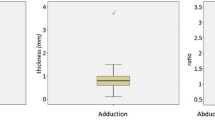Abstract
The usefulness of ultrasound measurements in the diagnosis of the subacromial impingement syndrome of the shoulder was evaluated. Fifty-seven patients with unilateral symptoms of the impingement syndrome underwent ultrasound examination of both shoulder joints, which included assessment of rotator cuff integrity, measurement of rotator cuff thickness and the distance between the infero-lateral edge of acromion and the apex of the greater tuberosity of humerus (AGT distance) in the standard ultrasonographic positions. As a control group, 36 volunteers (72 shoulders) with no history of shoulder pain were examined sonographically. Ultrasonographic assessment of humeral head elevation, measured as the AGT distance, proved to be useful in establishing the diagnosis of the subacromial impingement syndrome of the shoulder. A difference in rotator cuff thickness of more than 1.1 mm and a difference in the AGT distance of more than 2.1 mm between both shoulder joints may reflect dysfunction of rotator cuff muscles.



Similar content being viewed by others
References
Azzoni R, Cabitza P, Parrini M (2004) Sonographic evaluation of subacromial space. Ultrasonics 42:683–687
Bigliani LU, Levine WN (1997) Current concepts review - subacromial impingement syndrome. J Bone Joint Surg Am 79-A:1854–1868
Bretzke CA, Crass JR, Craig EV, Feinberg SB (1985) Ultrasonography of the rotator cuff, normal and pathologic anatomy. Invest Radiol 20:311–315
Desmeules F, Minville L, Riederer B, Cote CH, Fremont P (2004) Acromio-humeral distance variation measured by ultrasonography and its association with the outcome of rehabilitation for shoulder impingement syndrome. Clin J Sport Med 14:197–205
Gill TJ, McIrvin E, Kocher MS, Homa K, Mair SD, Hawkins RJ (2002) The relative importance of acromial morphology and age with respect to rotator cuff pathology. J Shoulder Elbow Surg 11:327–330
Graichen H, Bonel H, Stammberger T, Haubner M, Rohrer H, Englmeier KH, Reiser M, Eckstein F (1999) Three-dimensional analysis of the width of the subacromial space in healthy subjects and patients with impingement syndrome. Am J Roentgenol 172:1081–1086
Graichen H, Bonel H, Stammerger T, Englmeier KH, Reiser M, Eckstein F (1999) Subacromial space width changes during abduction and rotation—a 3-D MR imaging study. Surg-Radiol Anat 21:59–64
Hawkins RJ, Kennedy JC (1980) Impingement syndrome in athletes. Am J Sports Med 8:151–158
Hedtmann A, Fett H (1991) Atlas und Lehrbuch der Schultersonographie, 2nd edn. Ferdinand Enke Verlag, Stuttgart
Jacobson JA, Lancaster S, Prasad A, van Holsbeeck MT, Craig JG, Kolowich P (2004) Full-thickness and partial-thickness supraspinatus tendon tears: value of US signs in diagnosis. Radiology 230:234–242
Jerosch J, Castro WH, Sons HU, Moersler M (1989) Zur Atiologie des subacromialen Impingement-Syndroms-eine bio-mechanische Untersuchung. Beitr Orthop Traumatol 36:411–418
Mack LA, Gannon MK, Kilcoyne RF, Matsen RA 3rd (1988) Sonographic evaluation of the rotator cuff. Accuracy in patients without prior surgery. Clin Orthop Relat Res 234:21–27
Middleton WD (1989) Status of rotator cuff sonography. Radiology 173:307–309
Neer CS 2nd (1983) Impingement lesions. Clin Orthop Relat Res 173:70–77
Nyffeler RW, Werner CML, Sukthankar A, Schmid MR, Gerber C (2006) Association of a large lateral extension of the acromion with rotator cuff tears. J Bone Joint Surg 88-A:800–805
Ogata S, Uhthoff HK (1990) Acromial enthesopathy and rotator cuff tear: a radiologic and histologic postmortem investigation of the coracoacromial arch. Clin Orthop Relat Res 254:39–48
Ozaki J, Fujimoto S, Nakagawa Y, Masuhara K, Tamai S (1988) Tears of the rotator cuff of the shoulder associated with pathological changes in the acromion. A study in cadavera. J Bone Joint Surg Am 70-A:1224–1230
Reilly P, Amis AA, Wallace AL, Emery RJH (2003) Mechanical factors in the initiation and propagation of tears of the rotator cuff. J Bone Joint Surg Br 85-B:594–599
Seibold CJ, Mallisee TA, Erickson SJ, Boynton MD, Raasch WG, Timins ME (1999) Rotator Cuff: Evaluation with US and MR Imaging. Radiographics 19:685–705
Teefey SA, Hasan SA, Middleton WD, Patel M, Wright RW, Yamaguchi K (2000) Ultrasonography of the rotator cuff. A comparison of ultrasonographic and arthroscopic findings in one hundred consecutive cases. J Bone Joint Surg Am 82-A:498–504
Teefey SA, Rubin DA, Middleton WD, Hildebolt CF, Leibold RA, Yamaguchi K (2004) Detection and quantification of rotator cuff tears. Comparison of ultrasonographic, magnetic resonance imaging, and arthroscopic findings in seventy-one consecutive cases. J Bone Joint Surg Am 86-A:708–716
Tillander B, Norlin R (2002) Intraoperative measurements of the subacromial distance. Arthroscopy 18:347–352
Turrin A, Capello A (1997) Sonographic anatomy of the supraspinatus tendon and adjacent structures. Skeletal Radiol 26:89–93
Wallny T, Wagner UA, Prange S, Schmitt O, Reich H (1999) Evaluation of chronic tears of the rotator cuff by ultrasound. A new index. J Bone Joint Surg Br 81-B:675–678
Watson M (1989) Rotator cuff function in the impingement syndrome. J Bone Joint Surg Br 71-B:361–366
Weiner DS, Macnab I (1970) Superior migration of the humeral head. A radiological aid in the diagnosis of tears of the rotator cuff. J Bone Joint Surg Br 52-B:524–527
Wiener SN, Seitz WH Jr (1993) Sonography of the shoulder in patients with tears of the rotator cuff: accuracy and value for selecting surgical options. AJR Am J Roentgenol 160:103–107
Acknowledgments
The study was conducted in compliance with the current laws of the country in which it was performed and the appropriate approval from institutional review board was granted.
Author information
Authors and Affiliations
Corresponding author
Rights and permissions
About this article
Cite this article
Cholewinski, J.J., Kusz, D.J., Wojciechowski, P. et al. Ultrasound measurement of rotator cuff thickness and acromio-humeral distance in the diagnosis of subacromial impingement syndrome of the shoulder. Knee Surg Sports Traumatol Arthr 16, 408–414 (2008). https://doi.org/10.1007/s00167-007-0443-4
Received:
Accepted:
Published:
Issue Date:
DOI: https://doi.org/10.1007/s00167-007-0443-4




